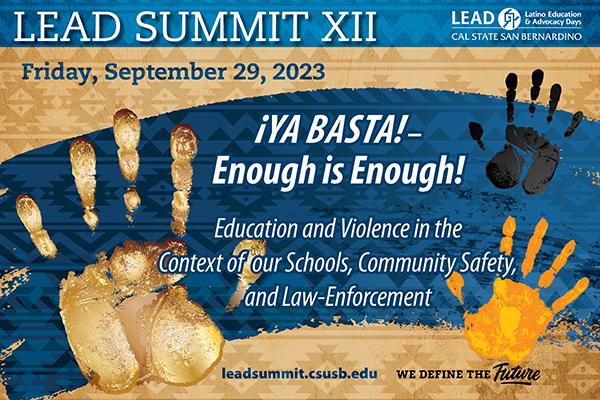LEAD Summit XII

Conferencia en la Universidad de Cal State San Bernardino
El 29 de septiembre se llevará a cabo la conferencia Latino Education and Advocacy Days, mejor conocida por su sigla en inglés como LEAD, que se traduciría como Día de Defensa de la Educación Latina. Esta actividad se desarrollará en el Centro de Estudiantes Manuel Santos, de la Universidad Estatal de California en San Bernardino (CSUSB)
El objetivo de la cumbre será promover y crear conciencia sobre la gravedad de la crisis que la educación latina enfrenta actualmente, y fortificar el desarrollo intelectual, cultural, y personal de los maestros, administradores, líderes y estudiantes de nuestras comunidades.
Todas las presentaciones se efectuarán en inglés, pero habrá intérpretes calificados de traducción simultánea a español disponible todo el día.
“¡Ya Basta! - Enough is Enough!: Education and Violence in the Context of our Schools, Community Safety, and Law-Enforcement"
Living a life free from violence is a basic human right enshrined in the Universal Declaration of Human Rights. Yet no community is free of the substantial harm and deleterious behavioral and psychological consequences that are associated with exposure to violence, especially when it is rooted in dehumanization.
Today, violent acts take various forms, including armed conflicts, gang violence, parent-to-child physical aggression (e.g., corporal punishment), terrorism, forced displacement, state violence, vigilante violence, mass incarceration, segregation, exclusion, silence, and invisibilization. Exposure to violence can be direct, e.g., being the victim of a violent act, or indirect, e.g., hearing about violence or witnessing violence involving others, which often leads to post-traumatic stress disorder. However, it can be well argued that for indigenous, people of color, and other marginalized peoples, there is no "post" trauma. The trauma is historic and intergenerational, but it is also present in everyday life today.
As a social phenomenon violence affects us all, but especially racially segregated and high-poverty neighborhoods. Violence takes lives and leaves a lasting legacy of trauma. The physical, emotional, and financial pain from violence cascades from individuals to their families and communities, including children. Violence takes on many forms - be it physical, sexual, emotional, psychological and spiritual. This has a long-lasting impact on the lives and future of our communities and societies. Although all communities and families are affected, Chicanos/Latinos/Indigenous ("Raza") are disproportionately at risk for victimization.
Some of the deadliest mass shootings in recent U.S. history have occurred in Latino communities. Violence is not only a critical public health issue but intersects with education in epic proportions and is a barrier to education. While every child has the right to safety and security that makes learning possible and fulfilling, millions of girls and boys experience violence in and around schools - on the way to school, on school grounds, and within classrooms. Evidence and data have clearly shown that violence in and around schools - in its various forms - has detrimental impacts on a child’s well-being and educational attainment. When children cannot learn in a safe and secure environment, they are unable to reach their full potential and are less likely to thrive and develop essential life skills to gain social and economic stability in the future.
And while the causes and consequences of violence are many-faceted, they are not random phenomenon, but rather follow patterns. Families and communities living in poverty are often relegated to neighborhoods where the underground economy and certain forms of crime will often be more tolerated and allowed by the police and other authorities, provided as those who control such doings confine their business to those zones. Police are often less likely to be visible in such neighborhoods and communities, and the officers are less likely to be recruited from there. Their lack of familiarity with such communities provides them with no basis for distinguishing between hardened criminals and law-abiding citizens. And the color of the officers often does not matter, as once institutionalized, many often become but blue. Not only do such zones have higher rates of violence, but they also experience greater incidents of law-enforcement brutality, harassment, and deaths. Currently, there is no accurate count of killings of Chicanos/Latinos/Indigenous ("Raza") by those in a law enforcement capacity in the United States. The same is true for other POCs.
I